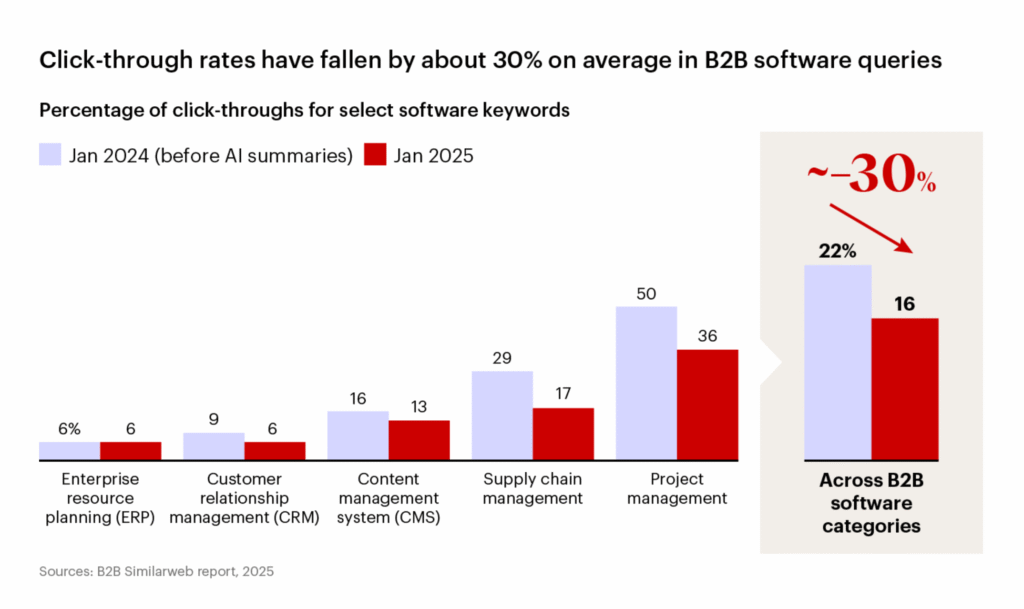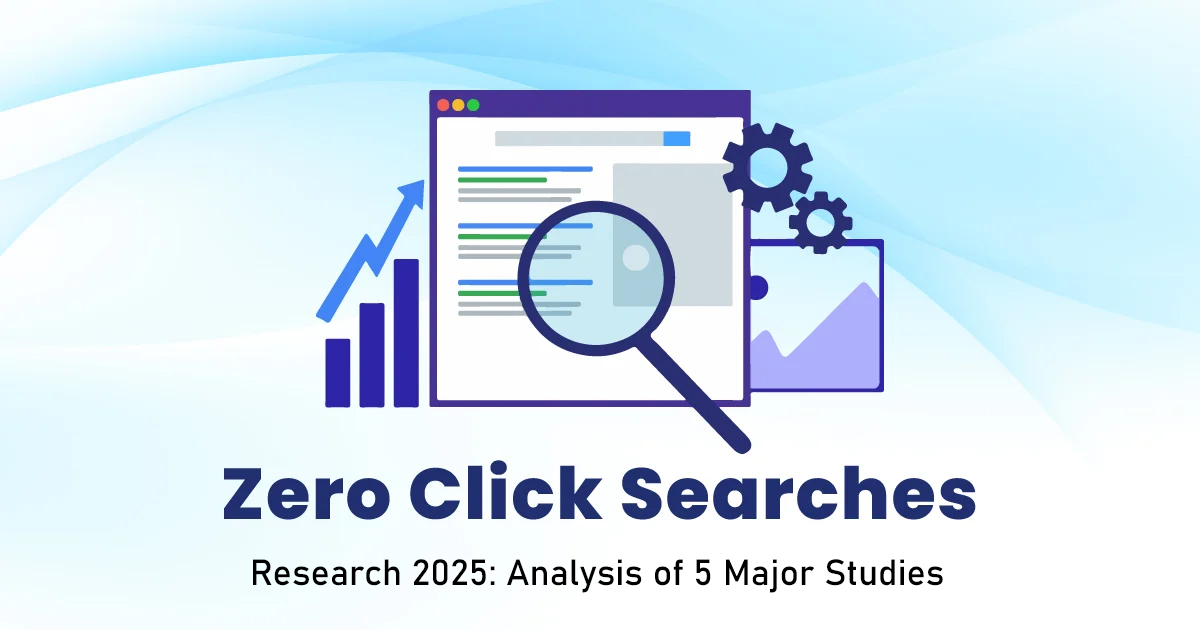Executive Summary
This research synthesizes findings from five major studies conducted by SparkToro, Datos, Bain & Company, and industry experts to provide a comprehensive analysis of the zero-click search phenomenon in 2025.
Our research shows that zero-click searches have hit a critical point: 60% of all Google searches in the US end without clicking on a website. This trend, which has been sped up by AI-powered search features, shows a big change in how people act online and has big effects on digital marketing plans.
The most important results show that mobile searches have even higher zero-click rates (77.2%), and B2B industries are seeing click-through rates drop by up to 30%. This study looks at the causes, effects, and strategic responses to this change in how people search.
Research Methodology
This comprehensive analysis draws from five primary research sources:
- SparkToro/Datos State of Search Q1 2025: Clickstream data from tens of millions of desktop users across US, UK, and EU
- Bain & Company Consumer Research: Survey of 1,100+ US consumers on search behavior
- SparkToro 2024 Zero-Click Study: Multi-million device clickstream panel analysis
- Bain & Company AI Agents Report: Analysis of AI’s impact on search and marketing
- Industry Expert Analysis: Insights from Neil Patel and other thought leaders
The synthesis of these studies provides a multi-dimensional view of the zero-click search landscape, combining quantitative clickstream data with qualitative consumer behavior analysis.
Introduction: The Zero-Click Search Phenomenon
Zero-click searches are a major change in how people use search engines. These searches end when users find the information they want right on the search engine results page (SERP) without having to click through to another website.
This study examines how this trend is expected to accelerate between 2024 and 2025 due to three main reasons:
- The addition and growth of search features that use AI
- Changing what users expect from getting information right away
- Search engines’ main goal is to keep users coming back.
The effects go beyond just traffic numbers; they also affect brand visibility, customer acquisition strategies, and the basic economics of digital marketing.
Data Analysis: Current State of Zero-Click Searches
Global Zero-Click Rates
Our analysis of the compiled research reveals stark geographic and platform differences:
United States Market: According to the SparkToro/Datos Q1 2025 study:

- Overall zero-click rate: 58.5% of all searches
- Organic clicks to external websites: 36% (360 per 1,000 searches)
- Clicks to Google properties: 28.5%
- Paid advertisement clicks: 1%
The March 2025 data shows acceleration: 27.2% of searches ended without any click, up from 24.4% in March 2024.
European Market (EU/UK):

- Zero-click rate increased to 37.40% year-over-year
- Only 374 clicks per 1,000 searches reach the open web
- Lower zero-click rates than US, potentially due to regulatory differences
Platform-Specific Analysis
Desktop vs. Mobile Divergence:
- Desktop zero-click rate: 25.6%
- Mobile zero-click rate: 77.2%
This 3x difference indicates that mobile users prioritize convenience and instant answers significantly more than desktop users.
AI-Powered Search Impact
Bain & Company’s February 2025 research provides critical insights:
- 80% of consumers rely on zero-click results for at least 40% of their searches
- Even AI skeptics report that ~50% of their queries are answered without clicking
- ChatGPT experienced 44% traffic growth in November 2024
- Perplexity reached 15 million monthly users
Key Findings from Major Studies
Finding 1: The Google Ecosystem Dominance
The SparkToro 2024 comprehensive study reveals a concerning trend:
“For every 1,000 searches on Google in the United States, only 360 clicks make it to a non-Google-owned, non-Google-ad-paying property.”
This represents:
- 14.3% of US searches clicking to Google properties (up from 12.1% in 2024)
- YouTube emerging as the #1 destination for both traditional and AI-powered searches
- Increasing monetization opportunities for Google while reducing external traffic
Finding 2: Consumer Behavior Transformation
Bain’s consumer research identifies behavioral shifts:
- 40-70% of LLM users utilize AI platforms for:
- Research and information summarization (68%)
- News and weather updates (48%)
- Shopping recommendations (42%)
This indicates that AI tools are not just supplementing but replacing traditional search for many use cases.
Finding 3: Traffic Impact Quantification
Bain’s AI Agents analysis provides concrete traffic data:
- A survey of more than 1,100 US consumers by Bain & Company found that 80% of them rely on these “zero-click” results for at least 40% of their searches.
- HubSpot has found that traffic to many company sites has decreased by up to 30%.
- Scrunch AI’s audit of anonymized search journeys across its clients’ websites finds that AI referral traffic is growing by about 40% monthly.
- Adobe Analytics reports that traffic to retailer websites from generative AI sources increased by 1,200% in February 2025 vs. July 2024.
Finding 4: B2B Sector Vulnerability

The March 2025 Bain study highlights B2B-specific challenges:
- B2B software categories experiencing up to 30% CTR decline
- 85% of B2B buyers purchase from their “day one” vendor list
- Reduced visibility into customer research and decision-making processes
Finding 5: Search Feature Evolution
Analysis of SERP features driving zero-click behavior:
- AI Overviews: Comprehensive summaries occupying 50% of screen real estate
- Featured Snippets: Capturing 35%+ of clicks when users do click
- Knowledge Panels: Instant entity information from authoritative sources
- People Also Ask: Creating infinite information loops on SERPs
- Local Packs: Providing complete business information without clicks
Impact Analysis by Industry
Severely Impacted Industries
Publishing and Media:
- Simple news queries answered directly on SERPs
- Significant ad revenue implications
- Traffic decreases of 25-30% reported
Informational Websites:
- Recipe sites losing traffic to ingredient lists in snippets
- How-to sites competing with step-by-step SERP features
- Educational content increasingly summarized by AI
Moderately Impacted Industries
E-commerce:
- Product information displayed in shopping features
- Price comparisons available without clicks
- However, transaction intent still drives clicks
B2B Services:
- Complex queries still require detailed exploration
- Longer sales cycles provide some insulation
- Relationship-building aspects remain click-dependent
Industries with Opportunities
Local Businesses:
- Enhanced visibility through local packs
- Direct conversion opportunities (calls, directions)
- Google Business Profile optimization critical
Entertainment and Gaming:
- Experience-based offerings require site visits
- Interactive content cannot be replicated in SERPs
- Community features drive direct traffic
Strategic Implications and Responses
1. Measurement Framework Evolution
Traditional metrics are becoming obsolete. Neil Patel’s analysis suggests new KPIs:
Primary Metrics:
- Search impression share
- SERP feature ownership rate
- Brand search volume growth
- Conversion rate optimization
Secondary Metrics:
- AI citation frequency
- Cross-platform visibility
- Earned media mentions
- Third-party validation signals
2. Content Strategy Adaptation
The research indicates successful strategies include:
Zero-Click Optimization:
- Targeting featured snippet opportunities
- Structured data implementation
- Concise, direct answers (40-60 words)
- Question-based content formatting
Beyond-Click Value Creation:
- Interactive tools and calculators
- Personalized experiences
- Community-building features
- Proprietary data and insights
3. Platform Diversification Imperative
With Google’s ecosystem dominance, the research points to critical diversification needs:
- YouTube optimization (now the #1 search destination)
- Social platform native content
- AI chatbot optimization
- Reddit and forum presence
4. Brand Building Over Traffic Chasing
The paradigm shift requires focusing on:
- Impression-based brand awareness
- Thought leadership positioning
- Authority building through citations
- Direct traffic cultivation
Future Projections
Based on trend analysis across all studies:
2025 Projections:
- Zero-click searches likely to exceed 70% by year-end
- AI Overviews expansion to majority of commercial queries
- Voice search becoming predominantly zero-click
- Platform-specific search overtaking Google in certain verticals
2026-2027 Outlook:
- Potential regulatory intervention in major markets
- Evolution of new monetization models
- Shift from traffic-based to impression-based advertising
- Emergence of zero-click-first content strategies
Conclusions and Recommendations
This research synthesis reveals that zero-click searches represent not a temporary trend but a fundamental shift in information consumption behavior. The 60% zero-click rate in 2025 marks a tipping point requiring an immediate strategic response.
Key Takeaways:
- The Traditional SEO Model Is Obsolete: Focusing solely on rankings and traffic is no longer sufficient. Read my new guide about this.
- Platform Control Is Intensifying: Google’s ecosystem capture of searches is accelerating.
- User Behavior Has Permanently Shifted: Instant gratification expectations are now the norm.
- Measurement Must Evolve: Success metrics need complete recalibration.
- Opportunities Exist for Agile Brands: Early adopters of zero-click optimization strategies can gain significant advantages.
Strategic Recommendations:
Immediate Actions:
- Audit current SERP feature presence
- Implement comprehensive structured data
- Develop featured snippet optimization program
- Establish new measurement frameworks
Medium-term Initiatives:
- Build platform-specific content strategies
- Invest in brand awareness campaigns
- Create interactive, non-replicable content
- Develop first-party data assets
Long-term Positioning:
- Transition from traffic to conversion focus
- Build direct audience relationships
- Establish thought leadership presence
- Prepare for post-click marketing reality
The evidence is clear: zero-click searches are not just changing SEO – they’re redefining the entire digital marketing landscape. Organizations that recognize and adapt to this reality will thrive, while those clinging to traditional metrics and strategies risk obsolescence.
References
- Fishkin, R. & Datos. (2025). State of Search Q1 2025: Behaviors, Trends, and Clicks Across the US & Europe. Datos. Retrieved from https://datos.live/report/state-of-search-q1-2025/
- Bain & Company. (2025, February). Goodbye Clicks, Hello AI: Zero-Click Search Redefines Marketing. Retrieved from https://www.bain.com/insights/goodbye-clicks-hello-ai-zero-click-search-redefines-marketing/
- Fishkin, R. (2024, July). 2024 Zero-Click Search Study: For every 1,000 EU Google Searches, only 374 clicks go to the Open Web. In the US, it’s 360. SparkToro. Retrieved from https://sparktoro.com/blog/2024-zero-click-search-study-for-every-1000-us-google-searches-only-374-clicks-go-to-the-open-web-in-the-eu-its-360/
- Bain & Company. (2025). Marketing’s New Middleman: AI Agents. Retrieved from https://www.bain.com/insights/marketings-new-middleman-ai-agents/
- Patel, N. (2025, February). Zero Click Searches & How They Impact SEO. Neil Patel Digital. Retrieved from https://neilpatel.com/blog/zero-click-searches/
This research represents a comprehensive analysis of publicly available studies and data. For questions about methodology or to discuss the findings, please contact the author.
Is a senior SEO expert with over a decade of experience dominating the digital marketing battlefield. Since 2023, I’ve been riding the AI wave. Since 2024, I have started to work with the SEO Bazooka Blog.

Leave a Reply